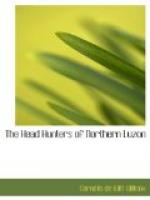Back in the main road, we stopped to rest at a point covered with a sensitive plant so delicate that, on stepping on it anywhere, the nervous thrill, if that is what it is, would run three or four feet or more in all directions before dying down. From this point we turned north, our way taking us through a broad open valley, past rice-fields and between clumps of flowering guava bushes. As we neared Bambang, where we were to spend the night, we were as before met by the local notabilities on horseback; and breasting a rise, we saw our road down in the plain in which this town lies, lined on both sides by all the school-children of the place, dressed in their very best clothes, some of them American fashion with shoes and stockings and looking mighty uncomfortable in consequence. Nearly everyone had a flag. Riding into the town, we found the plaza crowded with men and women, dressed mostly in white, and what with the flags, the church-bells clanging with all their might, the crowd, and the children trooping in, our cavalcade made a triumphant entrance.
We dismounted at the presidente’s, where muscatel and cocoanut milk were given us. A little muscatel goes a long way, but this is not true of the milk when one’s tongue is hanging out from riding in the sun, and there are only two or three cocoanuts. Filipinos apparently are not fond of this drink, and we nearly always had to send out and get more. No sooner were we in the house than addresses began, one of these being in Ilokano. The native language of Bambang, however, is the Isanay, spoken elsewhere only at Aritao and Dupax, a dying tongue, doomed to early extinction.
Bambang, like nearly all the other Nueva Vizcaya towns we had seen or were to see, shows signs of decadence. It has a good church and convento, a great plaza, and is surrounded by a fertile country, but something is missing. After dinner, I went over and called on the padre, one of the Belgians, whom we had met the day before. He informed me that Bambang had many Protestants, which he explained by the sharp rivalry between the Aglipayanos, or members of the “native” church, headed by the secessionist Aglipay, and the Catholics. To avoid the issues raised by this rivalry, many natives would appear to have abandoned the errors of Rome (or of Aglipayanismo, as the case may be) for those of the Reformation.




